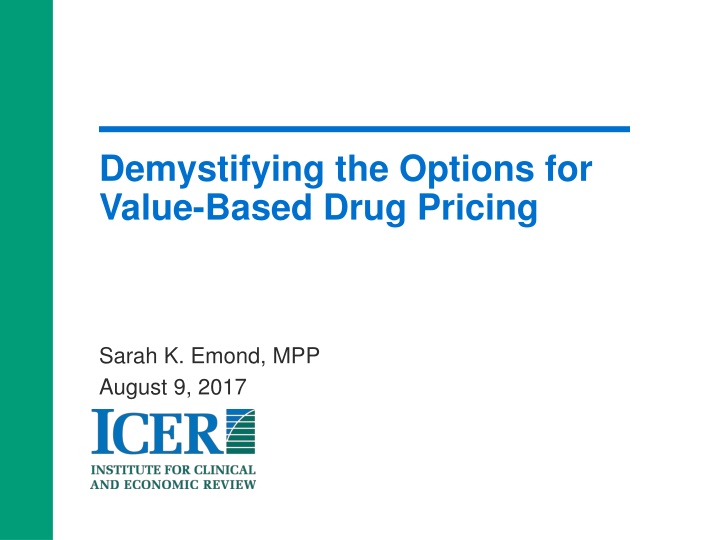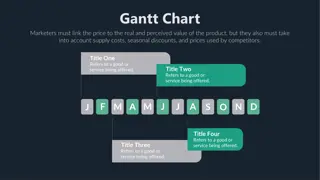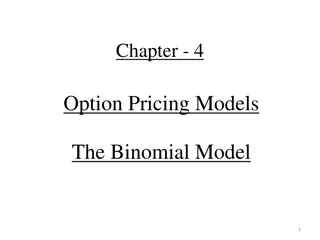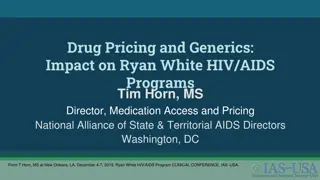
Value-Based Drug Pricing Strategies
Explore options like outcomes-based contracting, indication-specific pricing, and value-based formulary design to align pharmaceutical pricing with outcomes and patient experience. Learn about real-world examples and considerations for implementing these strategies.
Download Presentation

Please find below an Image/Link to download the presentation.
The content on the website is provided AS IS for your information and personal use only. It may not be sold, licensed, or shared on other websites without obtaining consent from the author. If you encounter any issues during the download, it is possible that the publisher has removed the file from their server.
You are allowed to download the files provided on this website for personal or commercial use, subject to the condition that they are used lawfully. All files are the property of their respective owners.
The content on the website is provided AS IS for your information and personal use only. It may not be sold, licensed, or shared on other websites without obtaining consent from the author.
E N D
Presentation Transcript
Demystifying the Options for Value-Based Drug Pricing Sarah K. Emond, MPP August 9, 2017
Working Group Charge (draft) This work group will develop for recommendation to the Health Care Cabinet, a proposal to create an actionable plan to align payer contracting with pharmaceutical manufacturers, PBMs, providers and pharmacies that aligns the value and price of prescription drugs to achieve the aims of improving outcomes and the patient experience, reducing overall medical costs and improving health equity. The recommendations will include meaningful actions that can be taken by state purchasers, regulators and or the legislature to promote the adoption of pharmacy purchasing strategies that achieve the above goals. (emphasis added)
Possible options Outcomes-based contracting Indication-specific pricing Value-based pricing Value-based formulary design and coverage policies
Outcomes-based Contracting What is it? Agreement between manufacturer and payer for rebates or refunds for achieving or not achieving certain clinical outcomes Has it been done? Harvard Pilgrim Health Care PCSK9s, Entresto, Trulicity Express Scripts for Iressa (lung cancer) Humana - 15 contracts currently in place, covering 20 drugs (no details disclosed) More examples and details
Outcomes-based Contracting Could it work? Payer wants to (has to) cover the drug Substantial uncertainty about the real-world clinical and/or cost-effectiveness of the drug Outcomes needed to establish clinical and/or cost- effectiveness are short-term, unambiguous, and administratively easy to obtain The pricing of the drug reflects a reasonable value whether the drug works well or not Cautions: Not that many drugs that fit the above criteria Some regulatory concerns Some analyses show little impact of contracts on actual drug spend (one PCSK9 deal is just 3% discount off of list; see Morning Consult)
Indication-specific Pricing What is it? A system of paying different prices for the same drug for different indications (predicated on the fact that drugs have different value for different indications) Has it been done? Express Scripts has launched an ISP program: Oncology Care Value Program (details from ESI) No data yet on how it has impacted outcomes or spending
Indication-specific Pricing Could it work? Great promise, and logically coherent (don t pay more for a second indication where the drug doesn t works as well) More and more data available to differentiate between effectiveness of multiple indications Classic example: Tarceva for non-small cell lung cancer, median survival gain is 3.4 months, but for pancreatic cancer patients only 1.4 weeks Cautions: Regulatory and reimbursement considerations (ASP, Medicaid best price, off-label marketing) Must have agreement between manufacturer and payer on effectiveness data/value determinations
Value-based Pricing What is it? Negotiating a price tied to independent value determination (e.g. ICER s value-based price benchmark) Has it been done? Hepatitis C Regeneron/Sanofi proactively priced Dupixent at ICER benchmark NY Medicaid will negotiate supplemental rebates for drugs priced above value-based benchmark 2016 survey showed 20% of plans using ICER reports for price negotiations
Value-based Pricing Could it work? Independence of external value determination allows for stronger negotiation stance Linking drug prices to value aligns with other health policy initiatives moving from volume to value Increasing interest from manufacturers to do value- based pricing Cautions: Can disrupt the rebate motive for payers and manufacturers Patients cost-sharing should be tied to best negotiated price, not list price
Value-based Formulary Design and Coverage Policies What is it? Takes the value-based price one step further ties negotiated price (and how close it is to the value- based price) to formulary placement or coverage/non-coverage decision; can use reference pricing and/or value-based ceiling prices Has it been done? Premera Blue Cross in WA state uses cost/quality- adjusted life year to inform formulary placement VA using ICER reports to negotiate prices and formulary status Several large purchasers exploring value-based formularies
Value-based Formulary Design and Coverage Policies Could it work? Formularies already set-up to tier adding tiering decision to achievement (or not) of value-based price is feasible Cautions: Patient cost-sharing should be mitigated; unfair to penalize patients, esp. those well-controlled on expensive drug, for behavior of drug company May be easier with novel PBM structure moving away from rebates as basis for negotiation
Value-based formulary ICER Clinical effectiveness rating A (Substantial) Cost relative to clinical value and corresponding formulary status = or $ = Preferred $$-$$$ = Co-pay $$$$ = Co-insurance, mandatory step Rx, or non-coverage = = Preferred $-$$ = Co-pay $$$/$$$$ = Co-insurance, mandatory step Rx, or non-coverage = or $ = Co-pay $$-$$$$ = Co-insurance, mandatory step Rx, or non-coverage = to $$$$ = Co-insurance, mandatory step Rx, or non-coverage Non-covered, mandatory step Rx, or Co-insurance B/B+ (incremental or better) C/C+ (equivalent or better) P/I (promising but inconclusive) C- (equivalent or inferior)
Value-based formulary 1: Value-based cost-sharing ICER Clinical effectiveness rating A (Substantial) Cost relative to clinical value and corresponding formulary status = or $ = Preferred $$-$$$ = Co-pay $$$$ = Co-insurance, mandatory step Rx, or non-coverage = = Preferred $-$$ = Co-pay $$$/$$$$ = Co-insurance, mandatory step Rx, or non-coverage = or $ = Co-pay $$-$$$$ = Co-insurance, mandatory step Rx, or non-coverage = to $$$$ = Co-insurance, mandatory step Rx, or non-coverage Non-covered, mandatory step Rx, or Co-insurance B/B+ (incremental or better) C/C+ (equivalent or better) P/I (promising but inconclusive) C- (equivalent or inferior) Drug companies have chosen to price far above demonstrated value to patients
Value-based formulary 2: Reference pricing with reimbursement caps ICER Clinical effectiveness rating A (Substantial) Cost relative to clinical value and corresponding formulary status = or $ = Preferred $$-$$$ = Co-pay $$$$ = Reimbursed up to value-based price = = Preferred $-$$ = Co-pay $$$/$$$$ = Reimbursed up to value-based price = or $ = Co-pay $$-$$$$ = Reference priced = or $ = Co-insurance or Non-covered $$-$$$$ = Non-covered or value-based price Non-covered or Reference priced B/B+ (incremental or better) C/C+ (equivalent or better) P/I (promising but inconclusive) C- (equivalent or inferior) I (insufficient evidence) Non-covered D (inferior) Non-covered Drug companies have chosen to price far above demonstrated value to patients






















